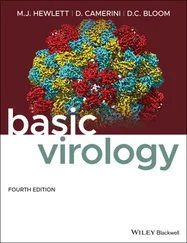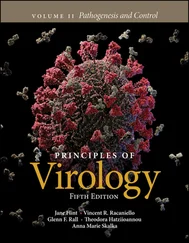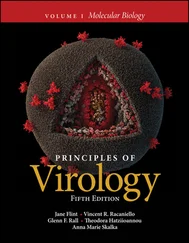Jane Flint - Principles of Virology
Здесь есть возможность читать онлайн «Jane Flint - Principles of Virology» — ознакомительный отрывок электронной книги совершенно бесплатно, а после прочтения отрывка купить полную версию. В некоторых случаях можно слушать аудио, скачать через торрент в формате fb2 и присутствует краткое содержание. Жанр: unrecognised, на английском языке. Описание произведения, (предисловие) а так же отзывы посетителей доступны на портале библиотеки ЛибКат.
- Название:Principles of Virology
- Автор:
- Жанр:
- Год:неизвестен
- ISBN:нет данных
- Рейтинг книги:3 / 5. Голосов: 1
-
Избранное:Добавить в избранное
- Отзывы:
-
Ваша оценка:
- 60
- 1
- 2
- 3
- 4
- 5
Principles of Virology: краткое содержание, описание и аннотация
Предлагаем к чтению аннотацию, описание, краткое содержание или предисловие (зависит от того, что написал сам автор книги «Principles of Virology»). Если вы не нашли необходимую информацию о книге — напишите в комментариях, мы постараемся отыскать её.
Volume I: Molecular Biology
Volume II: Pathogenesis and Control
Principles of Virology, Fifth Edition
Principles of Virology — читать онлайн ознакомительный отрывок
Ниже представлен текст книги, разбитый по страницам. Система сохранения места последней прочитанной страницы, позволяет с удобством читать онлайн бесплатно книгу «Principles of Virology», без необходимости каждый раз заново искать на чём Вы остановились. Поставьте закладку, и сможете в любой момент перейти на страницу, на которой закончили чтение.
Интервал:
Закладка:
Websites
http://viperdb.scripps.edu/Virus Particle Explorer
http://viralzone.expasy.org/ViralZone
http://www.virology.net/Big_Virology/BVHomePage.htmlThe Big Picture Book of Viruses
http://virology.wisc.edu/virusworld/Virusworld
STUDY QUESTIONS
1 Icosahedral virus particles are NOT stabilized by:Specific “cement” or “glue” proteinsCovalent bondsInteractions between adjacent protein layersTransmembrane connections of envelope to capsid proteinsNone of the above
2 Both picornaviruses (e.g., poliovirus) and polyomaviruses (e.g., simian virus 40) comprise small genomes packaged within icosahedral capsids.Indicate one similarity and two differences in the structures of poliovirus and simian virus 40 capsidsExplain how ONE of these capsids does not conform to the rules of quasiequivalence
3 Which of the following statements describes interactions among components of virus particles?Subunits usually associate via covalent bondsEach subunit has different bonding contacts with its neighborsCapsid subunits cannot interact with the internal viral genomeSubunits usually associate noncovalentlySubunit-subunit interactions are always sufficient to stabilize virus particles
4 It has long been known that virus particles can contain host cell molecules.Why is it difficult to be sure that host cell molecules found in enveloped virus particles are packaged specifically?If specific incorporation of a cellular protein into particles of a virus had been demonstrated, how would you investigate the functional importance of capture of the cellular protein?
5 Viral envelopes:Are invariably derived from host cell membranesContain viral glycoproteins with external and internal domains connected by transmembrane segmentsCan lie above or underneath a capsidAre generally impermeable to ions and charged moleculesAll of the above
6 What are the three modes of packing viral genomes in virus particles? Give an example of each mode of packaging.
7 Characteristic features of large virus particles do NOT include:Distinct parts with helical or icosahedral symmetryThe presence of multiple viral enzymesStructures dedicated to exit of the viral genomeMore than a single membraneA large DNA or RNA genome
8 Mature virus particles are said to be metastable.Explain what is meant by this term and why virus particles must be metastablePredict the consequences of a mutation that precludes formation of metastable virus particles during assembly and maturation
9 Which of the following statements about helical symmetry is INCORRECT?Helical viruses can contain RNA or DNA genomesThese genomes can be packaged by either specialized nucleic acid binding proteins or direct contact with coat proteinsAs the structure of a helix is open, the largest known viruses display helical symmetryHelical viruses can be naked or envelopedViral enzymes are present in many helical viruses that reproduce in animal cells
10 You have recently isolated a virus associated with a human disease. The virus particles are spherical, ~100 nm in diameter, and possess an envelope. Preliminary genome sequence analysis suggests the virus is not related to known human viruses.Indicate how you would determine the structure of this virus, and the rationale for your choice of methodWhich protein topology would you be most likely to find in the major capsid protein?
11 Subunits of viral capsid proteins are ~20 to 100 kDa.Explain how large icosahedral capsids can be assembled and how they differ from small capsidsWhat feature(s), other than genetic economy, dictates that all capsids are built from only a very small number of major structural proteins?
5 Attachment and Entry

Introduction
Attachment of Virus Particles to CellsGeneral Principles Identification of Receptors for Virus Particles Virus-Receptor Interactions
Entry into Cells Virus-induced Signaling via Cell Receptors Routes of Entry Membrane Fusion
Intracellular Trafficking and Uncoating Movement of Viral and Subviral Particles within Cells Uncoating of Enveloped Virus Particles Uncoating of Nonenveloped Viruses
Import of Viral Genomes into the Nucleus The Nuclear Pore Complex Nuclear Localization Signals Nuclear Import of RNA Genomes Nuclear Import of DNA Genomes Import of Retroviral Genomes
Perspectives
References
Study Questions
LINKS FOR CHAPTER 5
Video: Interview with Dr. Jeffrey M. Bergelson http://bit.ly/Virology_Bergelson
Video: Interview with Dr. Carolyn Coyne http://bit.ly/Virology_Coyne
Bond, covalent bond http://bit.ly/Virology_Twiv210
Breaking and entering http://bit.ly/Virology_Twiv166
A new cell receptor for rhinovirus http://bit.ly/Virology_4-30-15
Blocking HIV infection with two soluble cell receptors http://bit.ly/Virology_2-26-15
Changing influenza virus neuraminidase into a receptor binding protein http://bit.ly/Virology_11-21-13
Inside this very wood hidden the Greeks are waiting, for this machine was made for our castles, to spy on our houses and quickly move against our city or maybe hiding some other deception; don't trust in the horse, Trojans.
LAOCOÖN, VIRGIL’S THE AENEID, 29-19 B.C.E.
Introduction
Because viruses are obligate intracellular parasites, their genome must enter a cell for the viral reproduction cycle to occur. At first sight, the physical properties of the virus particles appear as obstacles to this seemingly simple goal. Virus particles are too large to diffuse passively across the plasma membrane. Furthermore, the viral genome is encapsidated in a protective coat that shields the nucleic acid as it travels through the harsh extracellular environment. These apparent obstacles must all be overcome during the process of viral entry into cells. Infection of cells by many, but not all, viruses requires binding to a receptor molecule on the cell surface. Exceptions include virus particles of yeasts and fungi, which have no extracellular phases, and plant viruses, which are thought to enter cells in which the cell wall has been physically damaged, for example, by insects or farm machinery.
In addition to binding viral particles, cell surface receptormolecules participate in entry, a process that relies on usurpation of normal cellular processes, such as endocytosis, membrane fusion, vesicular trafficking, and transport into the nucleus. The viral genome has to be released from the interior of the virus particle, a process known as uncoating. The receptor plays a role in this process by either initiating conformational changes that prime fusion or uncoating or by directing the virus particle into endocytic pathways, where fusion and uncoating may be triggered by low pH or by the action of proteases. These steps ultimately deliver the viral genome to the site of replication, which can be the cytoplasm, for most RNA-containing viruses, or the nucleus, for most DNA-containing viruses.
Attachment of Virus Particles to Cells
General Principles
In animals, viral infections usually begin at the body surfaces that are exposed to the environment ( Fig. 5.1; see also Volume II, Chapter 2). Epithelial cells cover these surfaces, and the region of these cells exposed to the environment is called the apical surface. Conversely, the basolateral surfacesof such cells are in contact with adjacent or underlying cells or tissues. These cells exhibit a differential (polar) distribution of proteins and lipids in the plasma membrane that creates the two distinct surface domains. Movement of macromolecules between the cells is prevented by tight junctions( Fig. 5.1).
Читать дальшеИнтервал:
Закладка:
Похожие книги на «Principles of Virology»
Представляем Вашему вниманию похожие книги на «Principles of Virology» списком для выбора. Мы отобрали схожую по названию и смыслу литературу в надежде предоставить читателям больше вариантов отыскать новые, интересные, ещё непрочитанные произведения.
Обсуждение, отзывы о книге «Principles of Virology» и просто собственные мнения читателей. Оставьте ваши комментарии, напишите, что Вы думаете о произведении, его смысле или главных героях. Укажите что конкретно понравилось, а что нет, и почему Вы так считаете.











